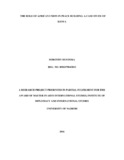| dc.description.abstract | The role of the African Union in managing Kenya‘s political crisis has not been adequately investigated, yet it is an excellent example of successful intervention by third party international actors in a domestic conflict. Several studies show that implementation of peace building models developed by third party actors have been unsuccessful, resulting in re-emergence of conflict, Notable failures in Somalia, Rwanda, and Bosnia lead to the perception that the UN action is too little too late, misconceived, poorly resourced, and poorly executed. The following were the specific objectives of this study; To critically examine the role played by African Union in domestic politics, To evaluate the effectiveness of the African Union in peace building in Kenya, and To establish factors behind the success of the African Union in peace building in Kenya. This study was carried out in African Union offices in Kenya as well as the ministry of foreign affairs that were involved in the Kenyan peace agreement. It will involve employees of different departments in the institutions. The study revealed that the field of conflict intervention and by extension conflict management has turned out to be more different and swarmed. Territorial, sub-local and other global associations and non-administrative associations and private people are progressively required in intervention exercises. Facilitate, it was built up that in excessively numerous occasions, clashes have been further disturbed by well-intentioned outsider performing artists who do not have a decent comprehension of intercession and sufficient planning. A strong handle of intercession through intervention is expected to better synchronize discretionary endeavors and oversee desires. To this end, the direction for successful intercession is a valuable asset. Moreover, the study built up that these middle people order nearby authenticity; have top to bottom learning of the general public, its history, and neighborhood strife determination approaches; and frequently host set up contacts with the contention gatherings. Be that as it may, this closeness to the contention and its on-screen characters has its inadequacies. It regularly opens nearby middle people to significant individual dangers; now and again they may likewise be seen as one-sided because of their association with either party. Promote, the study built up that the achievement of a peace understanding relies on upon the dedication of the gatherings; along these lines, assertions ought to dependably address the issues communicated by the gatherings (and the general public) and not those of the go-between. What's more, an effective understanding ought to limit itself to the primary issues of the present clash and leave space for a law based procedure to address all the less problems that are begging to be addressed. | en_US |



